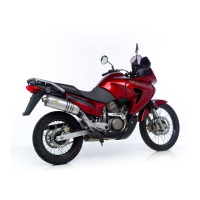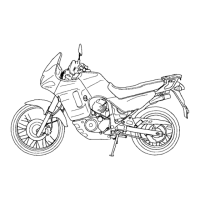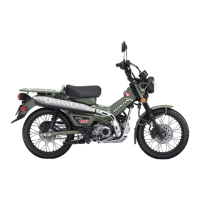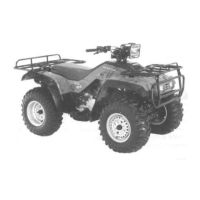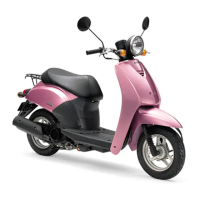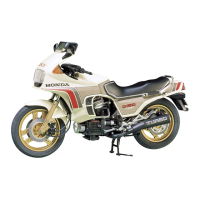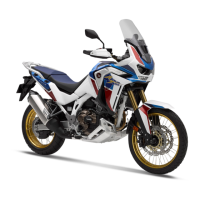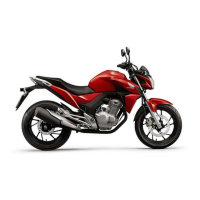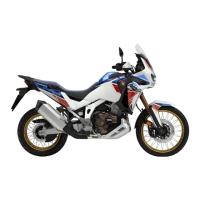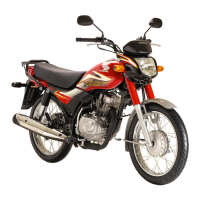
Do you have a question about the Honda Transalp XL700VA and is the answer not in the manual?
| Brand | Honda |
|---|---|
| Model | Transalp XL700VA |
| Category | Motorcycle |
| Language | English |
Essential guidelines for servicing and definitions of common abbreviations used in the manual.
Details on identifying the motorcycle model through serial numbers and labels.
Detailed technical specifications covering dimensions, frame, engine, electrical, lubrication, fuel, cooling systems.
Standard torque values for fasteners across various motorcycle systems like frame, maintenance, lubrication, and engine.
Identification and routing of key engine, fuel, electrical, and chassis components like cables and harnesses.
Explanation of emission sources and the function of crankcase and exhaust emission control systems.
Diagram illustrating the location of various body panels on the motorcycle.
General information for body panel and exhaust system removal/installation, including safety.
Torque specifications for fasteners related to the exhaust system, rear carrier, and sidestand.
Common troubleshooting issues for excessive exhaust noise and poor performance.
Procedure for removing and installing the motorcycle seat.
Procedure for removing and installing the side cover.
Procedure for removing and installing the rear carrier.
Procedure for removing and installing fender covers.
Procedure for removing and installing rear fender A.
Procedure for removing and installing rear fender C.
Procedures for removing and installing rear fender B for XL700VA and XL700V.
Procedure for removing and installing the inner center cowl.
Procedure for removing and installing the front side cowl.
Procedure for removing and installing the wire harness cover.
Procedure for removing and installing air guides for both sides.
Procedure for removing and installing the windscreen.
Procedure for removing and installing the headlight plate.
Procedure for removing and installing the front center cowl.
Procedure for removing and installing the front fender.
Procedure for removing and installing the under cowl.
Procedure for removing and installing the entire exhaust system, including muffler and exhaust pipes.
General service information for maintenance, including safety precautions and specifications.
Schedule detailing maintenance items, frequency, and recommended service intervals based on mileage and time.
Procedure for fuel tank lifting, inspection of fuel lines, and fuel tank lowering.
Instructions for checking and adjusting throttle grip freeplay and operation.
Procedure for inspecting and replacing the air cleaner element.
Procedure for removing, inspecting, and installing spark plugs, including gap measurement.
Procedure for inspecting and adjusting valve clearance while the engine is cold.
Procedures for checking engine oil level, recommended oil, and replacing the oil filter cartridge.
Procedures for checking coolant level, radiator air passage, and recommended antifreeze.
Inspection of the secondary air supply system components for deterioration or damage.
Procedure for inspecting and adjusting drive chain slack, cleaning, lubrication, and checking wear.
Procedures for brake fluid replacement, bleeding, pad wear inspection, and brake system inspection.
Inspection procedures for front and rear suspension, including steering head bearings.
Check that all chassis nuts and bolts are tightened to their correct torque values.
Inspection of wheels for looseness, tire pressure, and tread depth.
Diagram illustrating the flow of oil through the lubrication system.
General service information for the lubrication system, including safety and specifications.
Troubleshooting guide for common lubrication system issues like low oil level, low oil pressure, and oil contamination.
Procedure for checking oil pressure at the EOP switch using a gauge.
Procedure for removing the oil pump assembly from the crankcase.
Diagram illustrating the location of PGM-FI system components on the motorcycle.
General service information for the PGM-FI system, including safety and component specifications.
Troubleshooting guide for common PGM-FI system symptoms like engine not starting or rough idling.
Diagram showing the location of PGM-FI system components.
Schematic diagram of the PGM-FI system, showing electrical connections and components.
Diagrams illustrating the locations of various PGM-FI system connectors.
Information on diagnosing PGM-FI system problems using DTCs, self-diagnosis, and test procedures.
Index of Diagnostic Trouble Codes (DTCs) with corresponding function failures and troubleshooting references.
Detailed troubleshooting procedures for specific DTCs, such as MAP sensor and ECT sensor issues.
Procedure for relieving fuel pressure and removing the quick connect fitting for fuel line inspection.
Procedure for testing fuel pressure and inspecting for leaks.
Procedure for inspecting fuel flow by activating the fuel pump relay.
Procedure for removing and installing the fuel pump assembly, including cleaning the strainer screen.
Procedure for removing and installing the air cleaner housing.
Procedure for removing and installing the throttle body, including cable adjustments.
Procedure for removing and installing the injectors, including cleaning the base and checking for debris.
Procedure for removing and installing the Manifold Absolute Pressure (MAP) sensor.
Procedure for removing and installing the Intake Air Temperature (IAT) sensor.
Procedure for removing and installing the Engine Coolant Temperature (ECT) sensor.
Procedure for removing and installing the Camshaft Position (CMP) sensor.
Inspection procedure for the bank angle sensor's voltage output.
Inspection procedure for the engine stop relay operation.
Inspection procedures for ECM power and ground lines when the engine does not start.
Diagram illustrating the flow of coolant through the cooling system.
General service information for the cooling system, including safety precautions and specifications.
Troubleshooting guide for common cooling system issues like engine overheating, low temperature, and coolant leaks.
Procedures for testing the cooling system, including hydrometer test and coolant concentration.
Procedure for replacing coolant, including preparation and air bleeding.
Procedure for removing the thermostat and inspecting its operation.
Procedure for removing and installing the thermostat housing.
Procedure for removing and installing the radiator, including disconnecting hoses.
Procedure for removing, disassembling, and assembling the cooling fan.
Inspection procedure for the fan motor relay operation.
Procedure for removing and installing the water pump, including mechanical seal inspection.
Procedure for removing and installing the radiator reserve tank.
Diagram illustrating the location of engine mounting components and related parts.
General service information for engine removal and installation, including necessary support and components.
Torque specifications for engine mounting bolts, nuts, and related components.
Detailed step-by-step procedure for removing the engine from the motorcycle frame.
Detailed step-by-step procedure for installing the engine into the motorcycle frame.
Diagram illustrating the location of cylinder head components like camshafts, valves, and rocker arms.
General service information for rocker arm, camshaft, and cylinder head, including care during disassembly.
Specifications for cylinder compression, valve clearance, camshaft lobe height, journal O.D., and valve stem O.D.
Torque values for cylinder head bolts, nuts, cam sprocket bolts, and camshaft holder bolts.
Troubleshooting guide for engine top-end problems like low compression, excessive smoke, noise, and rough idle.
Procedure for measuring cylinder compression pressure to diagnose engine performance issues.
Procedure for removing the cylinder head cover, including disconnecting hoses and removing bolts.
Procedure for removing the camshaft, including timing marks and cam chain tensioner.
Procedure for removing the cylinder head, including draining coolant and loosening radiator bolts.
Procedure for disassembling the cylinder head, including removing cotters, springs, and valves.
Procedure for replacing valve guides, including heating the cylinder head and reaming new guides.
Procedure for inspecting and refacing valve seats using lapping tools and cutters.
Procedure for assembling the cylinder head, including installing valve springs, stem seals, and keepers.
Procedure for installing the camshaft, rocker arms, and camshaft holder assembly.
Procedure for installing the cylinder head, including aligning timing marks and cam chain guides.
Diagram illustrating the location of cylinder, piston, rings, and related components.
General service information for piston and cylinder, including care during removal and disassembly.
Specifications for cylinder I.D., piston O.D., ring end gap, and clearances.
Torque values for cylinder stud bolts.
Troubleshooting guide for cylinder/piston issues like low compression, excessive smoke, and abnormal noise.
Procedure for removing the cylinder, including bolts, hoses, and retaining clips.
Procedure for removing the piston, including piston pin clips and piston pin.
Procedure for installing piston rings into the piston grooves, including staggering end gaps.
Procedure for installing the piston into the cylinder, including O-rings and oil jet.
Procedure for installing the cylinder onto the piston, including dowel pins, gasket, and cam chain routing.
Diagram illustrating the location of clutch and gearshift linkage components.
General service information for clutch and gearshift linkage, including effects of engine oil on clutch.
Specifications for clutch lever freeplay, spring free length, disc thickness, and clearances.
Torque values for clutch lifter plate bolt, center lock nut, and primary drive gear bolt.
Tools required for clutch and gearshift linkage service, including clutch and gear holders.
Troubleshooting guide for clutch issues like hard engagement, slipping, and shifting problems.
Procedure for removing the right crankcase cover, including draining oil and removing bolts.
Procedure for removing the clutch assembly, including lifter piece and driven sprocket bolt.
Inspection of clutch plates for discoloration and warpage.
Procedure for removing and installing the primary drive gear, including CKP sensor bolts.
Procedure for removing and inspecting the gearshift spindle, including pinch bolt and oil feed pipe.
Procedure for installing the clutch assembly, including outer guide, drive chain, and clutch springs.
Procedure for installing the right crankcase cover, including bearings, oil seals, and return spring.
Diagram illustrating the location of alternator and starter clutch components.
General service information for alternator stator and flywheel, including charging coil and starter motor inspection.
Specifications for starter driven gear I.D./O.D. and starter clutch outer I.D.
Torque values for flywheel bolt, stator bolt, starter clutch torx bolt, and stator wire holder bolt.
Tools required for flywheel and rotor removal.
Troubleshooting guide for starter motor issues where the engine does not turn.
Procedure for removing the stator, including disconnecting electrical connectors and covers.
Procedure for removing the flywheel and starter clutch components, including idle and reduction gears.
Inspection of needle bearing, one-way clutch sprag, and clutch outer for wear or damage.
Procedure for installing the one-way clutch, clutch outer, and starter driven gear.
Procedure for installing the flywheel onto the crankshaft, including needle bearing and woodruff key.
Procedure for installing the stator into the left crankcase cover, including cleaning and applying locking agent.
Diagram illustrating the location of crankcase, crankshaft, and transmission components.
General service information for crankcase separation, crankshaft, connecting rod, and transmission.
Specifications for crankshaft clearances, main journal O.D., shift fork/shaft dimensions, and gear bushing I.D.
Torque values for crankcase bolts, crank pin bearing cap nuts, oil seal setting plate bolts, and transmission bearing bolts.
Tools required for crankcase, crankshaft, and transmission service.
Troubleshooting guide for engine noise, hard shifting, and transmission jumping out of gear.
Procedure for separating the crankcase halves, including removing bolts and cam chain tensioner.
Procedure for removing the crankshaft and connecting rod from the crankcase.
Inspection of connecting rod big end side clearance using a feeler gauge.
Procedure for removing connecting rod bearing cap nuts and caps.
Inspection of crankshaft journal surfaces for damage and checking crankshaft runout.
Procedure for installing bearing inserts, connecting rods, and caps onto the crankshaft.
Procedure for installing the crankshaft into the crankcase, including main journal lubrication.
Inspection and selection of crankpin bearings based on oil clearance and I.D. code.
Procedure for removing the mainshaft and countershaft from the crankcase.
Disassembly of mainshaft and countershaft, including inspection of gears and bushings.
Check bushings for wear or damage and measure O.D. and I.D.
Check spline grooves and sliding surfaces for wear or damage.
Check shift fork for deformation or abnormal wear.
Procedure for removing and inspecting the shift drum and its bearing.
Procedure for removing and installing crankcase bearings, including countershaft oil seal.
Procedure for removing and installing mainshaft and countershaft bearings in the left crankcase.
Procedure for removing and installing bearings in the right crankcase.
Procedure for assembling the crankcase, including oil filter boss, oil seals, and dowel pins.
Diagram illustrating the location of front wheel, suspension, and steering components.
General service information for front wheel, fork, and steering stem, including safety and specifications.
Specifications for minimum tire tread depth, cold tire pressure, axle runout, and fork fluid level.
Torque values for handlebar holder bolts, front axle, front brake disc bolts, and fork components.
Tools required for front wheel, suspension, and steering stem service.
Troubleshooting guide for steering issues, wheel wobbles, and suspension performance.
Procedure for removing and installing the handlebar, including levers, guards, and switches.
Procedure for removing the front wheel, including brake calipers and axle.
Inspection of wheel rim runout using a truing stand and dial indicator.
Procedure for checking and optimizing wheel balance, and applying balance weights.
Procedure for replacing wheel bearings, including removing dust seals and mounting tires.
Procedure for removing the front fork legs, including brake hose clamps and pinch bolts.
Procedure for disassembling the fork tube, including dust seals, springs, and pistons.
Measurement of the fork spring free length.
Inspection of fork tube, slider, piston, and rings for score marks, wear, or damage.
Procedure for assembling the fork, including installing piston rings, seals, springs, and fluid.
Procedure for removing and installing the steering stem, including bearings and seals.
Procedure for replacing steering head bearing outer races using special tools.
Procedure for installing the steering stem, top thread, and fork legs, including torque values.
Diagram illustrating the location of rear wheel, suspension, and swingarm components.
General service information for rear wheel, suspension, and swingarm servicing, including safety.
Specifications for minimum tire tread depth, cold tire pressure, axle runout, and shock absorber settings.
Torque values for rear axle nut, shock absorber mounting, swingarm pivot nut, and brake disc bolts.
Tools required for rear wheel, suspension, and swingarm service.
Troubleshooting guide for soft/stiff suspension, rear wheel wobbles, and wheel hard to turn issues.
Procedure for removing the rear wheel, including drive chain, axle nut, and side collars.
Inspection of wheel rim runout using a truing stand and dial indicator.
Procedure for checking and optimizing wheel balance, and applying balance weights.
Inspection and replacement of wheel/driven flange bearings for wear or damage.
Inspection of final driven sprocket teeth for wear or damage.
Procedure for replacing driven flange bearings, including removing old bearings and installing new ones.
Procedure for replacing wheel bearings in the hub, including driving in new bearings and installing collars.
Procedure for removing the shock absorber, including lower mounting bolt and side covers.
Inspection of the shock absorber damper unit for damage, leaks, and wear.
Procedure for replacing needle bearings in the pivot collars and dust seals.
Procedure for replacing needle bearings in the cushion arm using special tools.
Procedure for removing the suspension linkage assembly, including exhaust system and drive chain slider.
Procedure for removing the swingarm, including rear wheel, drive chain case, and brake caliper.
Procedure for disassembling and inspecting the swingarm, including pivot covers and chain slider.
Procedure for replacing pivot bearings in the swingarm, including removing collars and dust seals.
Diagram illustrating the location of front and rear hydraulic brake components.
General service information for hydraulic brake system, including safety and specifications.
Specifications for brake fluid, disc thickness, master cylinder, caliper, and piston dimensions.
Torque values for brake caliper bleed valve, master cylinder reservoir cap, and brake pad pin.
Troubleshooting guide for soft/spongy brake levers, hard levers, and brake drag issues.
Procedure for draining, filling, and bleeding the brake fluid for the XL700V model.
Procedure for draining, filling, and bleeding the brake fluid for the XL700VA model, excluding ABS modulator.
Procedure for replacing brake pads and inspecting brake discs for wear or cracks.
Procedure for removing, disassembling, and inspecting the front master cylinder.
Procedure for removing, disassembling, and assembling the front brake caliper for the XL700V.
Procedure for removing, disassembling, and assembling the front brake caliper for the XL700VA.
Procedure for removing, disassembling, and inspecting the rear master cylinder.
Procedure for removing, disassembling, and assembling the rear brake caliper.
Procedure for removing and installing the brake pedal, including spring and pinch bolt.
Diagram illustrating the location of ABS system components.
Schematic diagram of the ABS system, showing electrical connections and components.
General service information for the ABS system, including safety precautions and torque values.
Diagrams illustrating the locations of ABS system connectors.
Information on diagnosing ABS system problems using pre-start self-diagnosis and problem codes.
Explanation of ABS indicator blink patterns used to indicate problem codes.
Procedure for retrieving and erasing ABS problem codes using the SCS connector or HDS tester.
Index of ABS problem codes, their functions, symptoms, and troubleshooting references.
Troubleshooting procedures for issues with the ABS indicator light not coming on or staying on.
Troubleshooting procedures for ABS issues related to wheel speed sensors and solenoid valves.
Inspection and replacement procedures for the front wheel speed sensor.
Inspection and replacement procedures for the rear wheel speed sensor/VS sensor.
Procedure for removing and installing the PCV valve and brake pipes.
Inspection procedures for ABS modulator power/ground lines and failure reproduction.
Diagram of the battery and charging system, showing connections between alternator, regulator/rectifier, and battery.
General service information for the battery and charging system, including safety precautions and battery testing.
Specifications for battery capacity, current leakage, voltage, and alternator charging coil resistance.
Troubleshooting guide for battery issues (damaged, weak), current leakage, and charging system problems.
Procedure for removing and installing the motorcycle battery and battery tray.
Procedure for measuring battery voltage using a digital multimeter.
Information on recommended battery testers and procedures for battery testing.
Procedures for performing current leakage and charging voltage inspections.
Inspection and removal/installation procedures for the regulator/rectifier.
Inspection procedure for the alternator charging coil resistance and continuity.
Diagram of the ignition system, showing connections between ignition switch, ECM, sensors, and ignition coils.
General service information for the ignition system, including ECM, spark plugs, and troubleshooting.
Specifications for spark plug type, gap, ignition coil voltage, and ignition timing.
Torque value for the timing hole cap.
Tools required for ignition system inspection, including diagnostic testers and probes.
Troubleshooting guide for ignition system issues such as no spark, weak spark, or abnormal peak voltage.
Procedures for inspecting ignition system components, including peak voltage tests of ignition coils.
Procedure for measuring the CKP sensor peak voltage to diagnose ignition system issues.
Diagram of the electric starter system, showing connections between battery, switches, starter motor, and relays.
General service information for the electric starter system, including notices and component information.
Specification for starter motor brush length.
Torque values for starter motor cable terminal nut, assembly bolt, and brush mounting screw.
Troubleshooting guide for starter motor issues such as not turning, slow turning, or not engaging the engine.
Procedure for removing the starter motor, including disconnecting cables and removing bolts.
Procedure for disassembling the starter motor, including brushes, springs, and commutator inspection.
Procedure for assembling the starter motor, including installing brushes, springs, and covers.
Procedure for installing the starter motor into the crankcase, including connecting cables and routing wires.
Inspection procedures for the starter relay switch, including ground line and voltage checks.
Procedure for checking continuity between diode terminals.
Diagram illustrating the location of lights, meters, and switches on the motorcycle.
General service information for lights, meters, and switches, including bulb replacement and safety notes.
Specifications for bulbs, indicators, and fuses used in the lighting and meter systems.
Torque values for sidestand switch bolt, neutral switch, EOP switch, and combination meter mounting screw.
Troubleshooting guide for VS sensor/speedometer issues, including fuse, battery, and sensor air gap checks.
Procedure for replacing the headlight bulb, including safety precautions for handling halogen bulbs.
Procedure for replacing turn signal light bulbs and removing/installing the turn signal unit.
Procedure for replacing brake/tail light bulbs and removing/installing the brake/tail light unit.
Procedure for replacing the license light bulb.
Inspection of combination meter power/ground lines and back-up voltage line.
Inspection of speedometer and VS sensor operation, including voltage and continuity checks.
Procedure for checking tachometer operation and input peak voltage.
Inspection of ECT sensor and coolant temperature gauge operation, including resistance and continuity tests.
Inspection of the fuel level sensor and fuel meter for proper operation and circuit integrity.
Inspection procedure for the Oil Pressure Indicator (EOP Switch) operation.
Procedure for removing and installing the ignition switch.
Check for continuity of right handlebar switch terminals in each position.
Check for continuity of left handlebar switch terminals in each position.
Check for continuity of front and rear brake light switch terminals.
Inspection and removal/installation of the neutral switch.
Inspection and removal/installation of the sidestand switch.
Inspection and removal/installation of the horn.
Troubleshooting for turn signal lights not blinking, including fuse and relay checks.
Inspection procedure for the headlight relay operation.
Diagram of the immobilizer system, showing connections between ignition switch, ECM, sensors, and receiver.
General service information for the immobilizer system, including safety precautions and tool usage.
Procedure for registering new transponder keys to the immobilizer system.
Explanation of diagnostic code indications and troubleshooting procedures for system abnormalities.
Troubleshooting guide for HISS indicator issues, including fuse, meter, and ECM connector checks.
Inspection procedures for HISS indicator operation, including back-up voltage and signal line checks.
Inspection procedures for ECM power, ground, and signal lines related to the immobilizer system.
Inspection procedures for the immobilizer receiver's power, ground, and signal lines.
Wiring diagram for the XL700V model, illustrating electrical system connections.
Wiring diagram for the XL700VA model, illustrating electrical system connections, including ABS.
Troubleshooting steps for engine starting issues, including fuel line, spark plug, and PGM-FI system checks.
Troubleshooting steps for engine power loss, including drive train, tire pressure, and clutch inspection.
Troubleshooting steps for poor performance at low speed and idle, including intake air leaks and IACV inspection.
Troubleshooting steps for poor performance at high speed, including ignition timing and valve inspection.
Troubleshooting guide for steering issues, wheel wobbles, and motorcycle pulling to one side.
